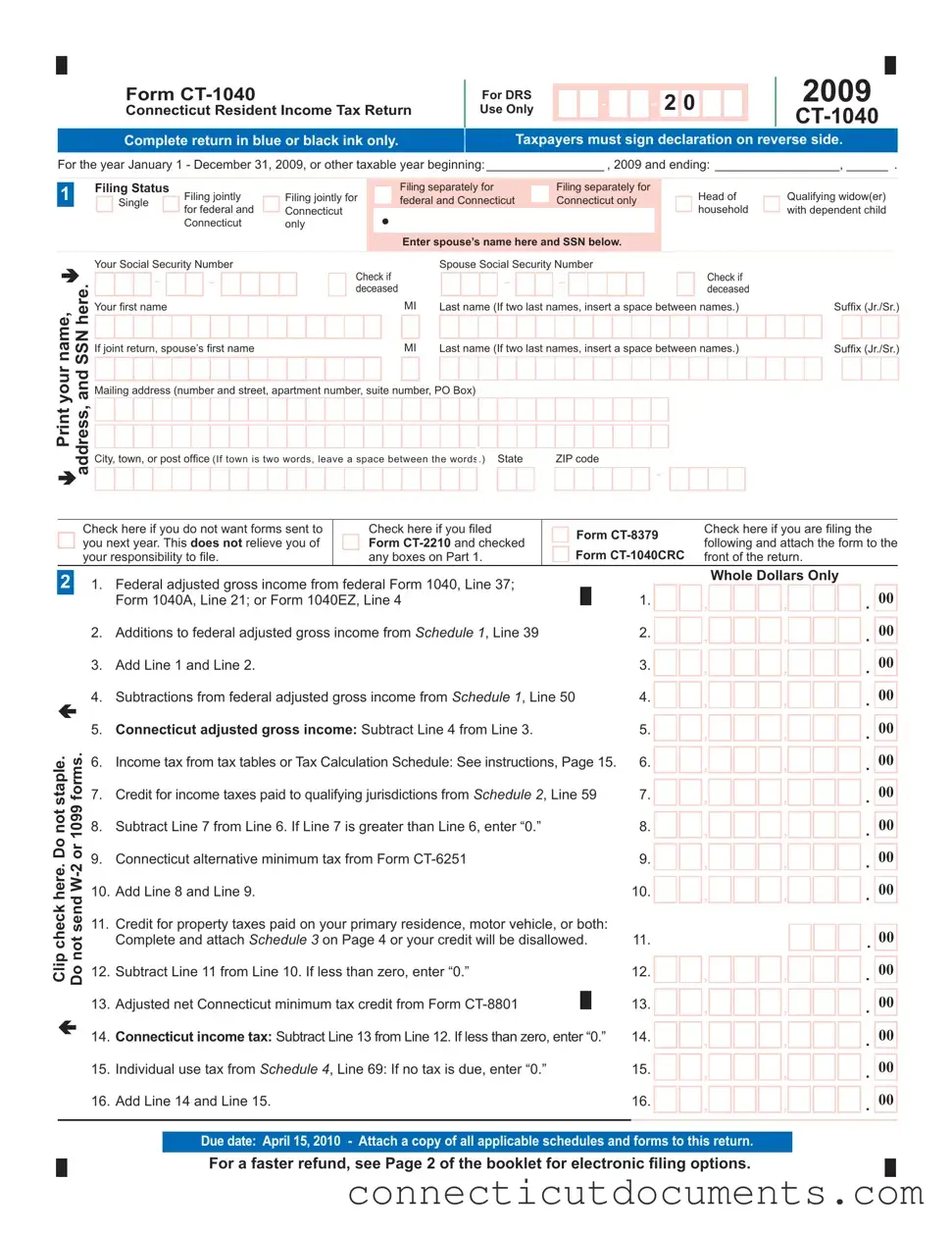The Form 1040, used for federal income tax returns, is the most comparable document to the CT-1040. Both forms require taxpayers to report their income, deductions, and credits to determine their tax liability. The federal Form 1040 is a comprehensive document that serves as the foundation for most individual tax filings across the United States, while the CT-1040 specifically addresses Connecticut residents, incorporating state-specific tax regulations and credits. Both forms require careful attention to detail and accurate reporting of financial information.
Another similar document is the Form 1040A, which is a simplified version of the federal Form 1040. This form is designed for taxpayers with straightforward tax situations, allowing them to report income and claim certain credits without the complexity of itemizing deductions. While the CT-1040 requires residents to report their Connecticut-specific income, the Form 1040A streamlines the process for those who qualify, making it easier to file while still ensuring compliance with federal tax laws.
The CT-1040 is also akin to the Form 1040EZ, which is the simplest federal tax return form available. Like the CT-1040, the Form 1040EZ is intended for individuals with uncomplicated tax situations, such as those who do not have dependents or itemized deductions. The primary difference lies in the fact that the CT-1040 incorporates state-specific rules and calculations, while the 1040EZ focuses solely on federal income tax. Both forms emphasize clarity and ease of use for taxpayers.
Form CT-2210 is another document that shares similarities with the CT-1040. This form is used to calculate penalties for underpayment of estimated tax. Taxpayers who may owe penalties for not paying enough tax throughout the year can use this form to determine their liability. While the CT-1040 focuses on the overall income tax return, the CT-2210 is an essential tool for ensuring compliance with estimated tax payment requirements, highlighting the importance of proactive tax management.
The CT-8379 is related to the CT-1040 in that it is used for claiming a refund of Connecticut income tax withheld for injured spouses. This form allows individuals who file jointly to protect their share of the refund from being applied to their spouse's tax debts. While the CT-1040 calculates the overall tax liability, the CT-8379 specifically addresses situations where a taxpayer's refund may be at risk, thus providing a layer of protection for eligible individuals.
Form CT-6251 is similar to the CT-1040 as it deals with the Connecticut alternative minimum tax (AMT). Taxpayers who may be subject to AMT must complete this form in conjunction with their CT-1040. The CT-6251 helps determine if a taxpayer's income exceeds the AMT thresholds, which can affect their overall tax liability. This connection underscores the importance of understanding both forms to ensure accurate tax reporting and compliance.
Form CT-8801 is another document that relates to the CT-1040, specifically concerning the Connecticut income tax credit for prior year minimum tax. Taxpayers who have previously paid AMT may be eligible for a credit in subsequent years, which can significantly impact their tax liability. This form works in tandem with the CT-1040 to ensure that taxpayers receive the benefits of any credits they are entitled to, reinforcing the need for thorough tax preparation.
Schedule 1, which accompanies the CT-1040, is similar to various federal schedules that allow taxpayers to report modifications to their federal adjusted gross income. This schedule is crucial for Connecticut residents, as it helps adjust their income based on state-specific rules. Just as federal schedules provide additional detail for the IRS, Schedule 1 serves the same purpose for the Connecticut Department of Revenue Services, ensuring accurate income reporting.
Schedule 2, which addresses credits for income taxes paid to qualifying jurisdictions, parallels the federal tax credit forms. This schedule allows Connecticut taxpayers to claim credits for taxes paid to other states, which can reduce their Connecticut tax liability. Like its federal counterparts, this schedule highlights the importance of understanding multi-jurisdictional tax obligations and ensuring that taxpayers receive appropriate credits for taxes already paid.
When establishing a limited liability company, it is vital to properly complete the required documentation to ensure compliance with state regulations, as highlighted by the California LLC-1 form. This form is not only essential for naming your LLC and designating its operational structure, but it can also be completed and submitted electronically through resources such as https://formcalifornia.com/editable-california-llc-1-form, streamlining the process for new business owners.
Lastly, the Schedule 3 for property tax credits is similar to various federal forms that address property-related tax deductions. This schedule allows Connecticut residents to claim credits for property taxes paid on their primary residence or motor vehicles. While federal forms may provide deductions for property taxes, Schedule 3 focuses specifically on credits available to Connecticut taxpayers, emphasizing the state's commitment to providing tax relief for property owners.
